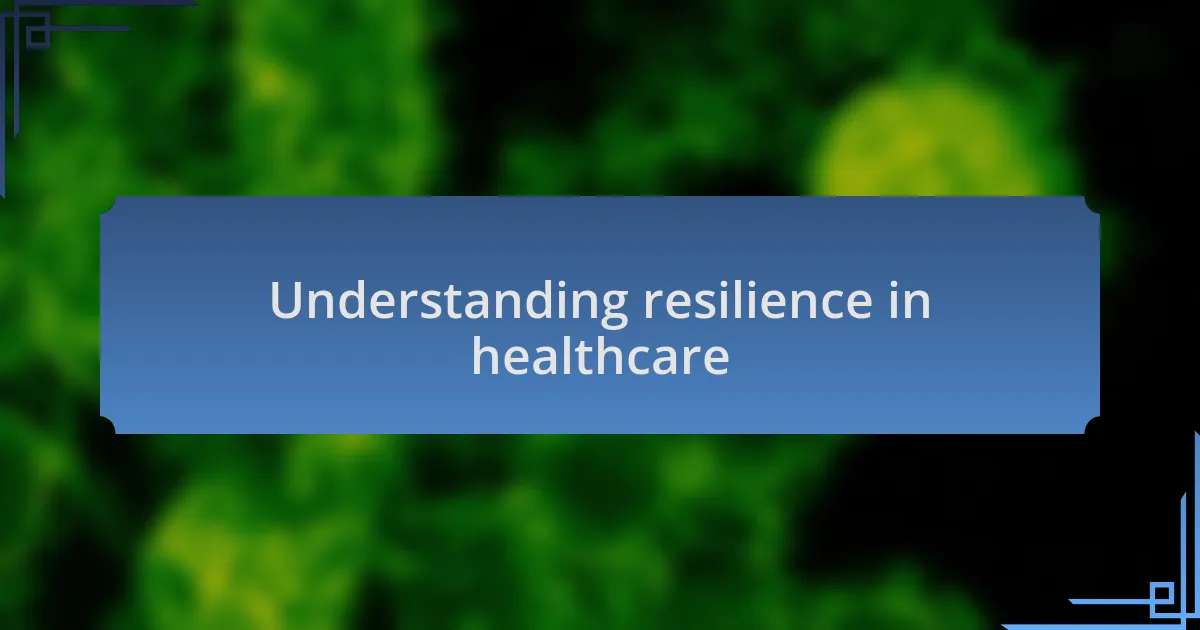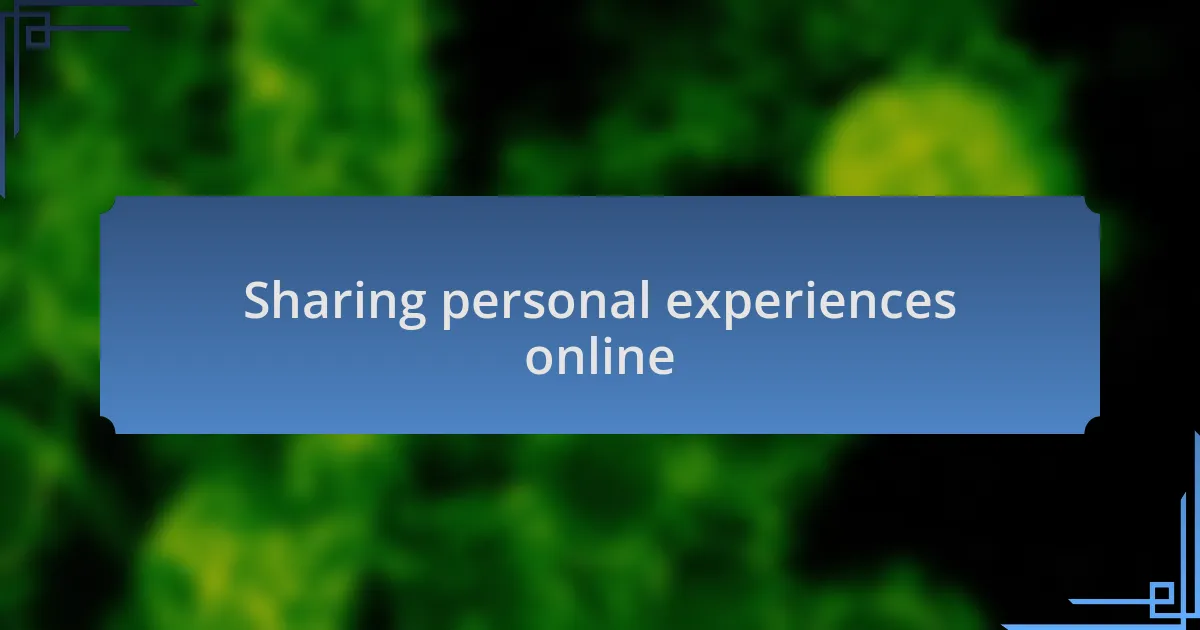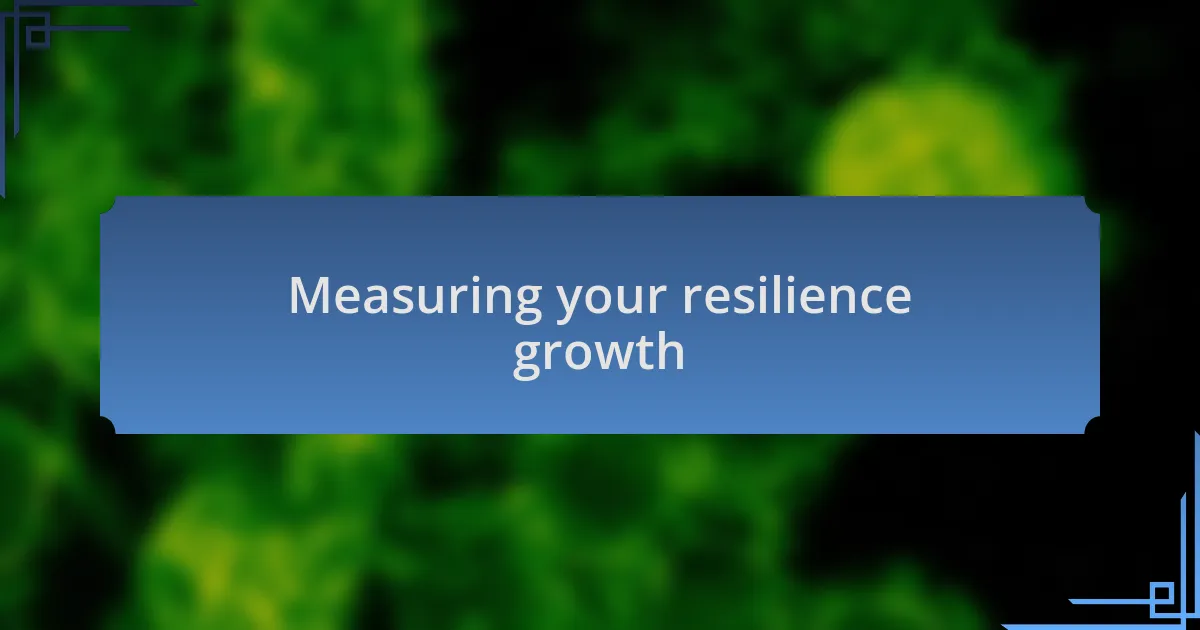Key takeaways:
- Resilience in healthcare is enhanced through teamwork, open communication, and self-care practices.
- Building resilience involves fostering strong relationships, adopting a growth mindset, and setting healthy boundaries.
- Engaging with the healthcare community and sharing personal experiences online creates connections and promotes mental health awareness.
- Measuring resilience growth can be achieved through reflective journaling, seeking feedback, and setting specific resilience goals.

Understanding resilience in healthcare
Resilience in healthcare refers to the ability of individuals and systems to adapt and thrive amidst challenges. I remember a particularly demanding week in the ICU, where stress levels were high, yet it struck me how teamwork and open communication helped us cope. Isn’t it fascinating how shared experiences can foster resilience, turning a rough day into a learning opportunity?
When I think about resilience, I often ask myself how healthcare professionals can maintain their well-being while caring for others. I’ve learned that practicing self-care—whether it’s taking a brief walk or engaging in mindfulness—can significantly enhance our ability to support patients. This interplay of personal well-being and professional duty shapes a stronger, more resilient healthcare environment.
Additionally, resilience isn’t just an individual trait; it’s often rooted in the culture of a healthcare organization. I’ve seen first-hand how institutions that encourage innovation and support their staff cultivate resilience effectively. In such spaces, challenges become less daunting, as everyone feels empowered to contribute to solutions. How powerful is that sense of collective resilience?

Strategies for building resilience
When it comes to building resilience, I’ve found that one of the most effective strategies is fostering strong relationships within your team. I recall a time when my colleagues and I faced a particularly challenging case. By sharing our thoughts and emotions in a supportive environment, we not only relieved stress but also forged deeper connections. How can we underestimate the power of camaraderie in tough times? It’s like a safety net that cushions us from the hard falls.
Another crucial strategy is adopting a growth mindset. Instead of seeing setbacks as failures, I’ve learned to view them as opportunities for learning. For instance, after a difficult shift, I reflect on what went well and what I could improve. This reflection not only boosts my resilience but also sharpens my skills for the future. Have you ever thought about how each struggle paves the way for personal growth? It truly transforms the way we approach our challenges.
Lastly, let’s not overlook the importance of healthy boundaries. I once struggled with saying no to extra shifts, thinking it showed dedication, but I soon realized it drained my energy. Setting limits allows for recovery and helps maintain enthusiasm for our work. How often do we forget that our well-being directly influences our ability to be fully present for our patients? Prioritizing self-care is not just a personal need, but a professional obligation to ensure we can provide the best care possible.

Engaging with the healthcare community
Engaging with the healthcare community can be both rewarding and empowering. I remember diving into a local forum where healthcare professionals discussed the latest trends in patient care. Sharing my experiences not only enriched the conversation but also highlighted the diverse perspectives within our field. Isn’t it fascinating how collective knowledge can propel us toward better practices?
I’ve also discovered that participating in webinars or live discussions allows for real-time exchange of ideas. One memorable event was a panel on mental health awareness, where I felt a genuine connection with fellow attendees. Our shared stories created an immediacy that transcended the digital medium. Have you ever felt that electric connection when people rally around a common purpose? It’s those moments that remind us why we engage in this field.
Moreover, leveraging social media can amplify our reach and influence. I started a small Twitter chat focusing on resilience in healthcare, and it quickly bloomed into a vibrant community. The questions and insights shared were eye-opening, and I realized how powerful it is to create a space where everyone’s voice matters. How can we harness this dynamic nature of social media to enhance our collaborative spirit further? It’s an ongoing journey that continually inspires me.

Sharing personal experiences online
Sharing personal experiences online can be a powerful tool for connection and healing. I vividly recall posting about a challenging case I faced; the outpouring of support and advice was overwhelming. It struck me how sharing vulnerability can ignite a sense of camaraderie—do we often underestimate the strength of community?
I’ve also noticed that when I share my triumphs along with my tribulations, it encourages others to open up. One time, I recounted my journey through caregiver burnout, and the comments flooded in with their relatable stories. It reinforced my belief that authenticity resonates deeply, sparking conversations that can lead to growth and understanding. Isn’t it incredible how our struggles can unite us in the most unexpected ways?
Moreover, as healthcare professionals, we have a unique opportunity to shape conversations around resilience and mental health. When I engaged in a Facebook group discussion about coping strategies during stressful shifts, I found people sharing their most intimate coping mechanisms. This exchange not only validated my own experiences but highlighted the importance of dialogue in breaking down stigmas. How can we continue to foster these honest discussions in our digital realms? For me, it underscores the responsibility we have to lead by example, embracing our narratives to inspire others.

Measuring your resilience growth
To assess your resilience growth, you might consider various metrics, both qualitative and quantitative. Personally, I keep a reflective journal where I document challenging situations and my responses to them. Over time, I’ve noticed patterns in my reactions and emotional states. This self-awareness has become a measure of my resilience; the more I adapt and recover from stress, the clearer it is that I am growing.
Another approach I find helpful is to seek feedback from trusted colleagues or friends. I once asked fellow practitioners for insight into how I handle setbacks. Their perspectives were eye-opening and often illuminated strengths I had overlooked. It’s fascinating how external viewpoints can serve as an invaluable gauge of our progress—have you ever asked someone how they perceive your reactions in tough times?
Lastly, setting specific resilience goals can provide a concrete way to track improvement. For instance, I often set a target for managing stress during particularly busy weeks. By reflecting on how well I met that challenge, I can realistically measure my growth. It prompts a question I often pose: how do you define success in your resilience journey? Finding answers might surprise you and lead to meaningful insights about your evolving capabilities.